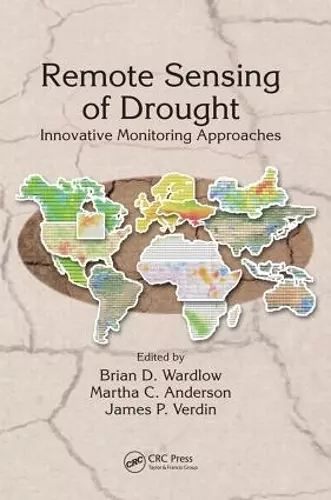Remote Sensing of Drought
Innovative Monitoring Approaches
Brian D Wardlow editor Martha C Anderson editor James P Verdin editor
Format:Hardback
Publisher:Taylor & Francis Inc
Published:24th Apr '12
Currently unavailable, and unfortunately no date known when it will be back
This hardback is available in another edition too:
- Paperback£81.99(9781138075207)

Remote Sensing of Drought: Innovative Monitoring Approaches presents emerging remote sensing-based tools and techniques that can be applied to operational drought monitoring and early warning around the world. The first book to focus on remote sensing and drought monitoring, it brings together a wealth of information that has been scattered throughout the literature and across many disciplines. Featuring contributions by leading scientists, it assembles a cross-section of globally applicable techniques that are currently operational or have potential to be operational in the near future.
The book explores a range of applications for monitoring four critical components of the hydrological cycle related to drought: vegetation health, evapotranspiration, soil moisture and groundwater, and precipitation. These applications use remotely sensed optical, thermal, microwave, radar, and gravity data from instruments such as AMSR-E, GOES, GRACE, MERIS, MODIS, and Landsat and implement several advanced modeling and data assimilation techniques. Examples show how to integrate this information into routine drought products. The book also examines the role of satellite remote sensing within traditional drought monitoring, as well as current challenges and future prospects.
Improving drought monitoring is becoming increasingly important in addressing a wide range of societal issues, from food security and water scarcity to human health, ecosystem services, and energy production. This unique book surveys innovative remote sensing approaches to provide you with new perspectives on large-area drought monitoring and early warning.
"This is by far the most comprehensive book on drought studies using satellite remote sensing. The book brings new insights, methods, and approaches to advance remote sensing of drought monitoring by: (a) proposing and discussing new indices, (b) demonstrating operational potential for early warning, (c) integrating and linking a variety of drought related information by studying indicators such as vegetation, evapotranspiration, snowmelt, soil moisture, and precipitation, and (d) providing local, regional, national, and global perspectives. The book is edited and written by some of the highly respected members of the remote sensing community with long years of experience. This book is a must for anyone interested in seeking the most advanced and sophisticated methods of studying Meteorological, Hydrological, Agricultural and Socioeconomic Droughts using advanced remote sensing data, methods, and models."
—Dr. Prasad S. Thenkabail, U.S. Geological Survey
"Brian Wardlow, Martha Anderson, and James Verdin have prepared a seminal book on the interrelationship between drought management and the application of remote sensing technologies to the complex challenges associated with drought monitoring and early warning. ... a timely and informative collection of contributions focused on new technologies that can address the challenges of drought monitoring ..."
—From the Foreword by Donald A. Wilhite, Professor and Director, School of Natural Resources, University of Nebraska–Lincoln
"I would definitely consider buying this book because I find it interesting to see what prominent authors in the field of drought and vegetation monitoring see as innovative and pre-operational methods at the global scale. … A book like this can help to reinforce the message that high quality early warning and monitoring products can be provided to the community and to decision makers as long as there is political commitment and continuity in the provision of earth observation data."
—Felix Rembold,Joint Research Centre of the European Commission, Italy
"This is by far the most comprehensive book on drought studies using satellite remote sensing. The book brings new insights, methods, and approaches to advance remote sensing of drought monitoring by: (a) proposing and discussing new indices, (b) demonstrating operational potential for early warning, (c) integrating and linking a variety of drought related information by studying indicators such as vegetation, evapotranspiration, snowmelt, soil moisture, and precipitation, and (d) providing local, regional, national, and global perspectives. The book is edited and written by some of the highly respected members of the remote sensing community with long year of experience. This book is a must for anyone interested in seeking the most advanced and sophisticated methods of studying Meteorological, Hydrological, Agricultural and Socioeconomic Droughts using advanced remote sensing data, methods, and models." —Dr. Prasad S. Thenkabail, U.S. Geological Survey
"Brian Wardlow, Martha Anderson, and James Verdin have prepared a seminal book on the interrelationship between drought management and the application of remote sensing technologies to the complex challenges associated with drought monitoring and early warning. ... a timely and informative collection of contributions focused on new technologies that can address the challenges of drought monitoring ..."—From the Foreword by Donald A. Wilhite, Professor and Director, School of Natural Resources, University of Nebraska–Lincoln
"I would definitely consider buying this book because I find it interesting to see what prominent authors in the field of drought and vegetation monitoring see as innovative and pre-operational methods at the global scale. … A book like this can help to reinforce the message that high quality early warning and monitoring products can be provided to the community and to decision makers as long as there is political commitment and continuity in the provision of earth observation data."—Felix Rembold,Joint Research Centre of the European Commission, Italy
ISBN: 9781439835579
Dimensions: unknown
Weight: 816g
484 pages